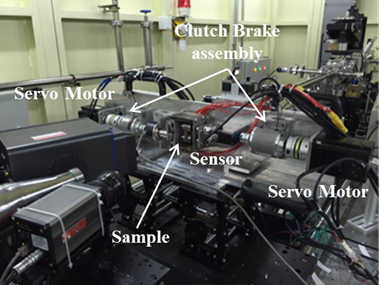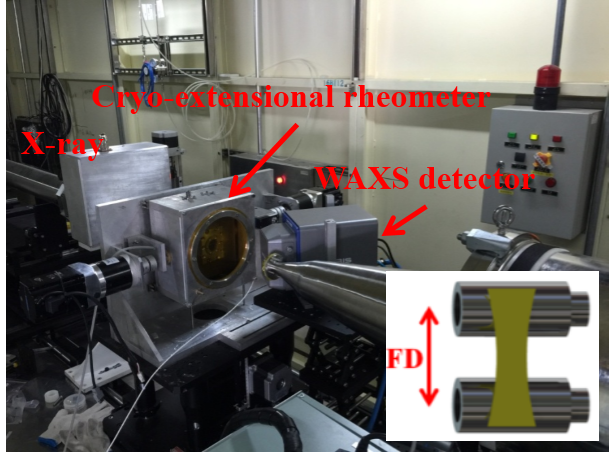Nonequilibrium physics under harsh conditions
In general, the high performance is processed or used under harsh conditions, such as intense flow of polymer film during processing, extension of high strength fiber under high vapor pressure, application of rubber under low temperature condition. The above issues refer to flow-induced crystallization, phase separation and other structural evolutions under far from equilibrium condition. In order to study the multi-scale structure evolutions under harsh conditions, we developed series experimental setups, which can combine with synchrotron radiation X-ray scattering techniques for in-situ measurements. Combining the high time resolution of synchrotron radiation X-ray scattering techniques and the setups we developed, it is expected to lay a theoretical foundation for the processing and application of high performance polymer materials under harsh conditions.
High strain rate

We first develop a rapid stretching device which can measure the mechanical property of TPEs in a considerable strain rate range (10-2 s-1 to 102 s-1) and large strain. And then, we focus on the fluoroelastomer F2314, which is a kind of copolymer of fluorinated alkenes and also TPE. In the present work, combining the synchrotron radiation SAXS and WAXS, multiscale structural evolution of fluoroelastomer F2314 during deformation is tracked in situ with a time resolution of 2 ms. The homemade rapid stretching device provides evidence for the strain rate dependence of mechanical response of fluoroelastomer F2314 in a large strain rate range. The evolution of crystal, hard domain and the compatibility of soft and hard domain are investigated, and their contributions on the stress-strain behavior are discussed. It is found that the multiscale structure is the origin of the strain rate dependence of mechanical response of fluoroelastomer F2314. The combination of structure detection and mechanical property measurement within a wide strain rate range is of great significance to fully understand the relationship between structure and performance of TPEs.
Jiarui Chang, Zhijie Xia
Obaid Iqbal, Habumugisha Jean Claude
Low temperature

We first designed a homemade cryo-extensional rheometer (at -155℃ to 25℃) which can be combined with SR-WAXS and stretched the vulcanized nature rubber samples at various low temperatures. The temperature dependency of strain-induced crystallization is detailed discussed both in stress-strain curves and structural information. Force bearing units at different strain stage are discovered according to quantitative analysis of WAXS patterns. We propose a model for nature rubber which depicts the construction progress of crystalline network at low temperatures. The combination of structural evolution and mechanical property at low temperature is of great significance to fully understand the service performance of NR under harsh condition.
Yuanfei Lin, Pinzhang Chen
Jingyun Zhao, Yuwei Fang